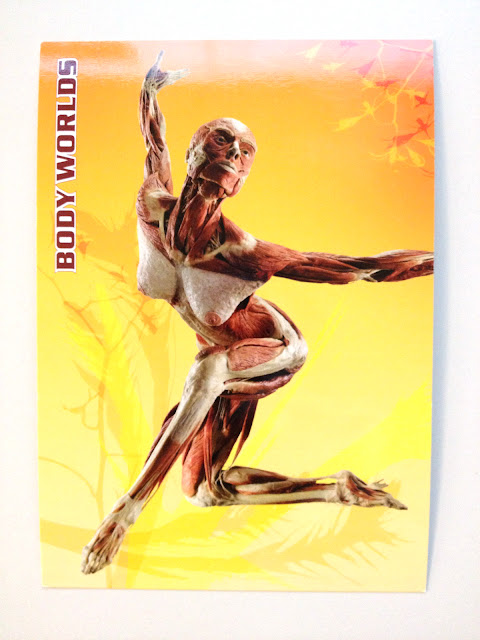BodyWorlds: PULSE at Discovery Times Square
This weekend, I was fortunate enough to visit the BodyWorlds: PULSE exhibit at the Discovery Museum in Times Square, New York. This amazing exhibit of more than 200 preserved human specimens included at least 10 full bodies and several dozen individual organs, organ systems, bones, and tissue. The process how the specimens are preserved is called "plastination," which entails replacing the organic body fluids with a hard plastic solution and dyes. The process was created by German anatomist and scientist Gunther Von Hagens in 1977.
the "kneeling lady" plastinate, about halfway through the exhibit
from left: exhibit info card, "kneeling lady" souvenir postcard, exhibit ticket, "football players" plastinates souvenir postcard
Before we entered, the docents allowed a small group to gather and then led us into a small room that played a two minute introduction video. We were a little confused with it once it started: how did the stop-motion drawing animation and lengthy monologue about the speed of life relate to the exhibit? Oh yeah, it's about the "pulse" of life. The thing about having a video introduction to this sort of show is that it is incongruous with the bodies because the specimens are literally frozen in time. They have been preserved and have no pulse. Regardless, it was a fascinating display, and I learned a lot more about the human body, its processes, and development. I also found some elements of the exhibit very interesting in addition to the ones listed below. There were several videos and animations, explaining the effect of LDL and HDL cholesterol on the bloodstream, the importance of stress management, neural connections in the brain, and blood cell traffic. There was also a blood pressure cuff that visitors could measure their own pulse. (Mine was 112/75, a healthy, resting number). One feature that I thought was neat was that many of the plastinates were placed behind a frosted glass panel, giving them a little "privacy" from the main area. This way, visitors could go into the body's own "space" for viewing, off the main walkways of the exhibit.
A few of the highlights of the exhibit:
- The "Skin Man," a full-body plastinate posed holding his own skin. This was the first body in the exhibit, and definitely a striking sight. The skin is the largest human organ, weighing at least 11 pounds.
- "Football Players," two full-body plastinates posed in a football tackle
- Baby progression from 4 weeks to full term. There were tiny embryos, partially-developed fetuses, and mostly- to full-term- babies preserved in cases. The centerpiece full-body plastinate in this part of the exhibit was a fully-preserved pregnant woman with a developed baby inside her uterus. The body is displayed with the stomach and uterus open, so you can see the inverted-positioned baby inside (head down, feet up).
- Tae Kwon Do man, a man in a tae kwon do pose with several sections of his musculature held open by surgical skin spreaders to show various surgical staples and pins, examples of how cosmetic or injury-related corrections are made.
- Old Man Smoker, a man plagued with black lungs and limited respiratory function due to years of dedicated smoking.
- Couples Pose, a woman posed kneeling on the thighs of a man
- Lungs in various conditions - emphysema, lung cancer, smoker's lung, entire vein system
- Vascular system - the entire blood system of a heart, a leg, a head, and a lamb
- Central nervous system - all of the main nerve connections from the brain, down the spinal cord, and into the extremities
- Normal joints and artificial joints - hip, knee, elbow
- What a family eats in a week - photos of families around the world with their entire weekly food intake. Not surprisingly, families in places like India ate mostly fruits and vegetables and handmade bread products, and in the USA and Australia, families feasted on fruits and vegetables as well, but they also ate more fast food, soda, and snacks.
There are many other individual other bodies and parts (pun intended) of the exhibit, but I guess you'll just have to go there and see it for yourself!



.jpg&container=blogger&gadget=a&rewriteMime=image%2F*)

Comments